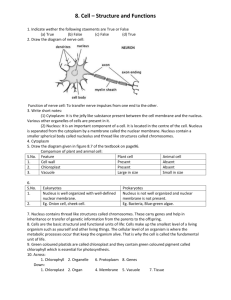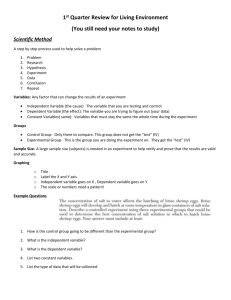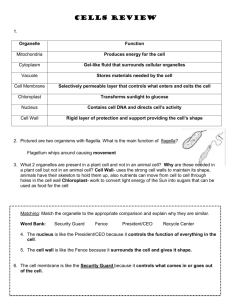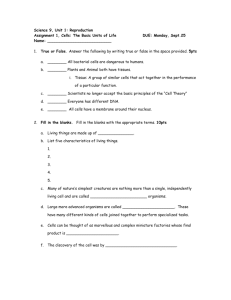2-cells - WordPress.com
advertisement
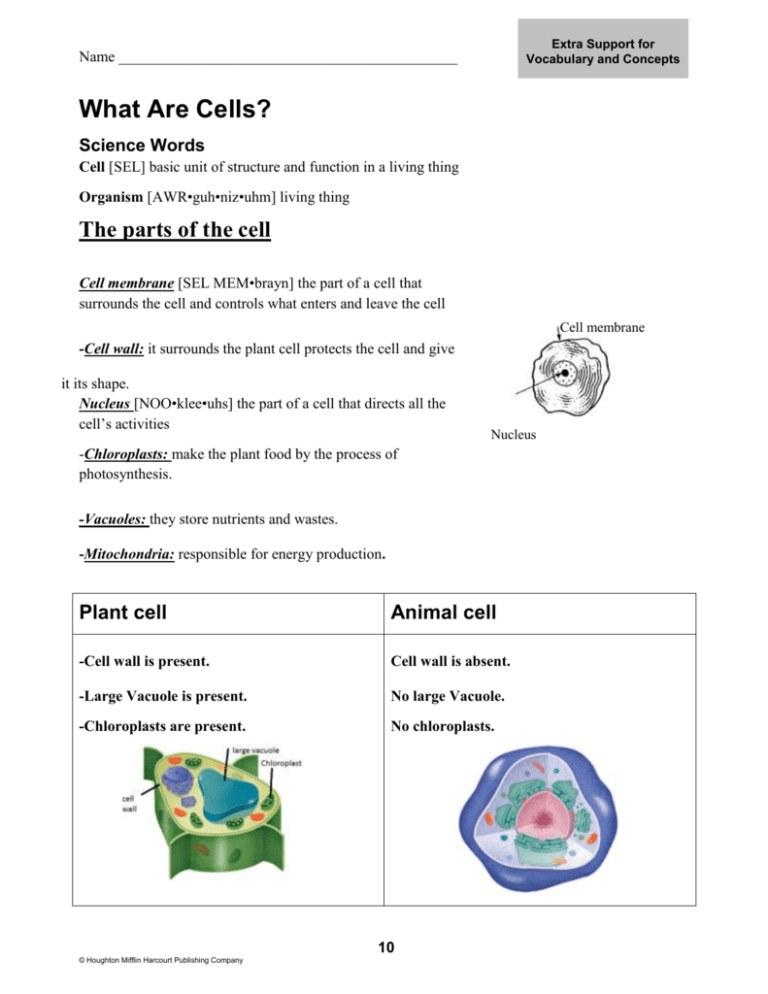
Extra Support for Vocabulary and Concepts Name _____________________________________________ What Are Cells? Science Words Cell [SEL] basic unit of structure and function in a living thing Organism [AWR•guh•niz•uhm] living thing The parts of the cell Cell membrane [SEL MEM•brayn] the part of a cell that surrounds the cell and controls what enters and leave the cell Cell membrane -Cell wall: it surrounds the plant cell protects the cell and give it its shape. Nucleus [NOO•klee•uhs] the part of a cell that directs all the cell’s activities Nucleus -Chloroplasts: make the plant food by the process of photosynthesis. -Vacuoles: they store nutrients and wastes. -Mitochondria: responsible for energy production. Plant cell Animal cell -Cell wall is present. Cell wall is absent. -Large Vacuole is present. No large Vacuole. -Chloroplasts are present. No chloroplasts. 10 © Houghton Mifflin Harcourt Publishing Company Name _____________________________________________ Extra Support for Vocabulary and Concepts What Are Cells? 1.The cell theory: -All living things are made of cells; -All the processes of life take place in the cell; -New cells come from existing cells. 2. All cells have a cell membrane; plant cells also have a cell wall to protect the cell. 3. For an organism to grow, the cells of the organism divide and make more cells. 4. Genes, which are part of an organism’s DNA, control the organism’s features. 5. Chromosomes in the nucleus of each cell are made of DNA. 6. Mitosis is cell division that allows for the body’s growth. Inherited trait [in•HAIR•uh•tuhd TRAYT] a characteristic passed from parents to their offspring Dominant trait [DAHM•uh•nuhnt TRAYT] a strong trait . Recessive trait [rih•SES•ihv TRAYT] a weak trait 11 © Houghton Mifflin Harcourt Publishing Company Name _____________________________________________ Extra Support for Vocabulary and Concepts A-Choose the best answer: 1-Which of these would you find in a plant cell but not in an animal cell? nucleus cytoplasm chloroplast mitochondria 2-Each part of a cell has a particular job to do. For example, a vacuole’s job is storing water, nutrients, and wastes. Which pairing correctly matches a cell part with its job? cell membrane: directing all cell activities mitochondria: releasing energy for cell use nucleus: shaping cell and holding cell parts cytoplasm: surrounding the cell 3-A scientist looks at a cell under a microscope and makes this chart of what she finds: Cell Part Observed cell membrane yes nucleus yes mitochondria yes chloroplast yes cell wall yes What kind of cell does the scientist conclude this is? amoeba bacteria animal plant 4-Carlos is studying a cell under a microscope. He observes the structure that directs the cell’s activities. What is it called? cell membrane chloroplast cytoplasm nucleus 5-Jenna uses the microscope to look at a plant cell and an animal cell. She draws a sketch of what she sees. What do her sketches show? Only the animal cell has chloroplasts. The plant cell doesn’t have a cell wall. The animal cell has more than one nucleus. The plant cell has a thicker outer covering than the animal cell has. 12 © Houghton Mifflin Harcourt Publishing Company Name _____________________________________________ Extra Support for Vocabulary and Concepts B-Match the clue on the left to the term on the right. 1-These contain an organism’s genetic information A. chloroplasts 2-A stiff outer layer that surrounds the cell B. cell wall 3-The cell’s control center C. nucleus 4-Where food is made during photosynthesis D. chromosomes C-Use this space to complete this graphic organizer. Critical D-DNA contains codes that determine your physical characteristics. What are some of those characteristics that are found in your DNA? . . 13 © Houghton Mifflin Harcourt Publishing Company



